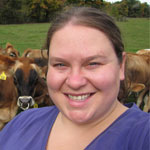
Colostrum was first. Our vet’s first question was how much do we feed. Having Jerseys, we’ve always fed 4 quarts in the first 12 hours after birth. Now we feed them 6 quarts. Do you know why we didn’t think to feed them more colostrum? Because that’s the way we’d always done it. It used to be enough. For some reason, it’s always been easy to believe that biology can change, but our standard practices never did. In hindsight, we should’ve seen the correlation. They’d always get sick right when their passive immunity decreased and just before their active immunity increased. Why wouldn’t we guess that more colostrum, and thus more immunoglobulins, would only benefit them?
The next change we made was how we treated sick calves. We put our medicines and needles away, and instead, we started treating the dehydration instead of the infection. We learned that if we could get them through the worst of the dehydration by feeding or tubing electrolytes, the gut infection would sort itself out.
The last change was simply a scheduling issue. I made sure that I was the one to feed calves at least once a day. I’m not saying that we didn’t have good, reliable calf feeders, because we did! But no one feeds your calves like you do. No one sees the things you see. I’ve said it before and I’ll say it again thousand times again, consistency in the people dealing with your animals makes a big difference in cow health.
So, if you’re having issues in one part of your farm, maybe don’t spend the hundreds or thousands of dollars on all the miracle products like we have. Start by going back to the basics.

The author dairies in partnership with her parents and brother at Spruce Row Farm in Pennsylvania. Jessica is a graduate of Pennsylvania State University, and since 2015, she has been active in promoting dairy in her local community. You can find her and her 250 Jersey cows on Facebook at Spruce Row Dairy or on Instagram at @seejessfarm.








